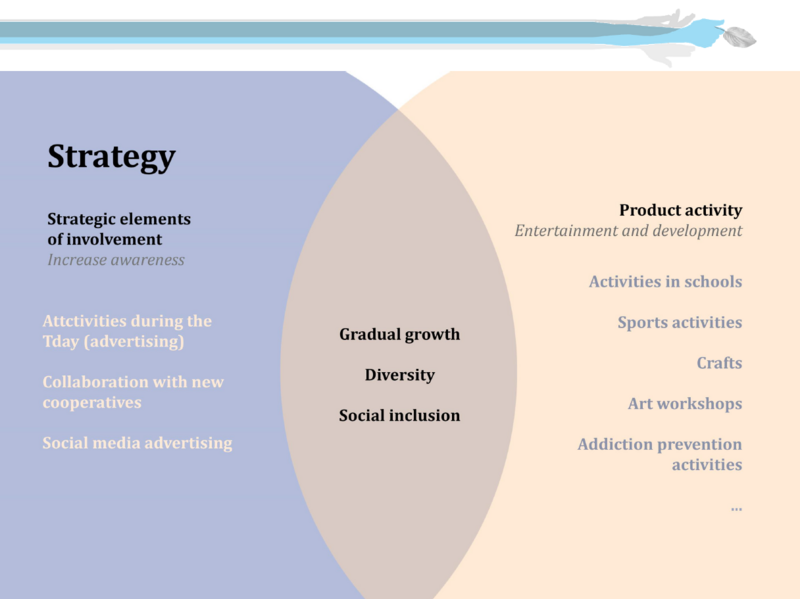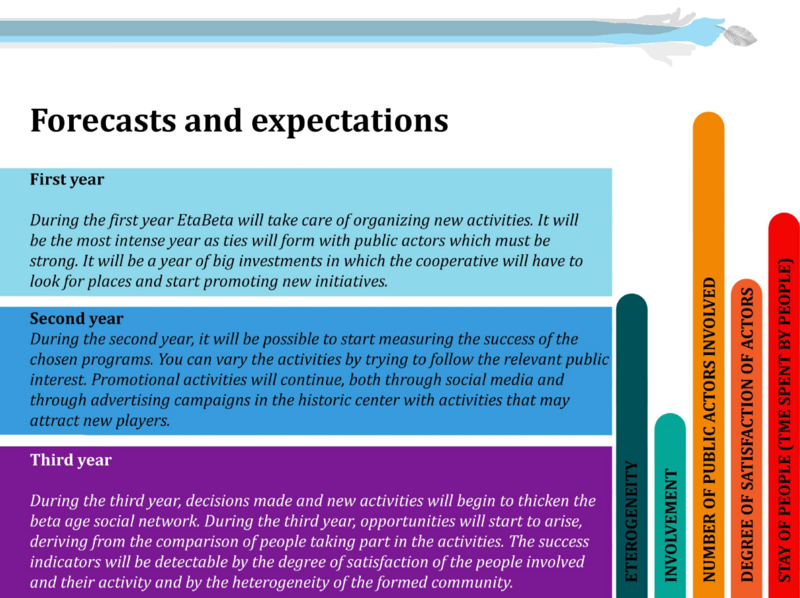LED2LEAP 2020 - Bologna Team 1
Jump to navigation
Jump to search
>>>back to working groups overview
Landscape Democracy Rationale
- This context is relevant for the landscape democracy perspectives, in fact the fundamental concepts at the basis of this social cooperative ONLUS (EtaBeta) are the social integration, equality and environmental sustainability. These values belong to the community, which has created a socially useful space within empty space
Location and scope
- Location : Italy,Bologna 40138, Villaggio del fanciullo]]
- Next to showing us where you are, you may also use this map to localise different focus themes of your community
Mapping
- EtaBeta is a company that works with public and private entities in order to promote appropriate opportunities for socialization and social inclusion. The projects and programmes are aimed mainly at people in situations of fragility and social marginality. The community offers to listen to the needs of people and public bodies by finding together with them initiatives and solutions to identify socio-rehabilitation paths of start-up work.
Groups of actors and stakeholders in your community
- The principal stakeholders are municipal and private asociations like Azienda USL di Bologna, Caritas, Confederazioni Sindacali Cgil, Cisl, Uil, Unindustria Bologna, CNA Bologna, Legacoop Bologna, Gestori e ospiti SPRAR e CAS Bologna, Arcidiocesi di BolognaComunità ebraica di Bologna, Coordinamento islamico di Bologna, UNHCR, Fondazione Innovazione Urbana. The components of the community are the operators, children, the elderly, drugs addicts, prisoners, and the socially less visible people.
Relationships between your actors and groups
- The person protagonist of the rehabilitative social path is the bearer of a wealth of values from an emotional and economic cultural point of view. EtaBeta is responsible for bringing out these values, highlighting them in order to enable social and work integration.
- Relationships between the groups
-Sharing of learning sites -Sharing of workplaces -Socio-cultural participatory activities
Results: The community creates a equal bond between participants. They are invited to participate by sharing their life experiences and valutes, creating a collective support network.
- Farming
- Cooking
- Training courses
- Handicraft & Construction
- Library of natural materials
Social activities
- School activities
- Informal activities
Summary of your learnings from the transnational discussion panel on April 22
On April 22 you will present the PPT version of this first assignment to other seminar groups working in other geographical community contexts. Please give here a short summary of your learnings during this presentation, for example:
- Other analytical approaches
- Other representation styles
- Other value schemes: any surprises?
- Constructive comments we received on our presentation
Theory reflection
- The seminar lessons were useful in analyzing this phase. Furthermore, direct knowledge of EtaBeta's values, through a meeting with the founder, allowed us to understand the structure and objectives of the association
References
- Site: https://www.etabeta.coop
- Site: https://it-it.facebook.com/pages/category/Arts---Entertainment/Spazio-Battirame-272818529726268/
Phase B: Democratic Landscape Analysis and Assessment
The Scene in your Story of Analysis
- The challenge of landscape democracy created by Eta Beta is the rehabilitation and reintegration process for drug addicts and people with social problems who participate in the activities proposed by the cooperative.
The Actors in your Story of Analysis
- The characters involved in the cooperative are the protagonists, the 3 basic pillars around which "the individual" operates are: Health, community and creativity. The path is composed of moments of sharing and collaboration in which members compare each other. In fact, the physical spaces within which these activities are carried out are not rigid but flexible and free of obstacles for a continuous debate and exchange of ideas; at the same time the individual participant is well aware of his specific role and his position within the cooperative. As a result of simple collaboration, after a few years participants can be hired and can become working members of the community itself.
The Story of Analysis
- In 2006 the association became a non-profit social cooperative of the mixed type A B, born what we know today as EtaBeta: these cooperatives deal both with services to people (A) (retirement homes, social assistance ...) and offer jobs for disadvantaged people (B). The cooperative now collaborates with the municipality of Bologna and other national and non-national associations.The people who take part in the rehabilitation and reintegration process participate in the activities proposed by the cooperative. The proposed activities are agricultural, manufacturing, culinary and culinary, and the cooperative is still developing today reinventing itself to every need and adding new programs and activities. The cooperative produces furniture and deals with glass processing. Chandeliers and dishes are just examples of products that today are sold all over the world, both to individuals and to renowned restaurants and chefs. The flexibility of this cooperative, which is sensitive to the different needs of society as they change over time, has meant that EtaBeta was not passively and negatively affected by the covid crisis, on the contrary, it has managed to create jobs
Reflection on our story
- Our community is a community that must be analyzed and understood both from the human point of view of the relationship between the actors that make it up, and from the abstract metaphysical point of view, in a perspective of transformation with time and with the events that day by day they become part of it and characterize it. EtaBeta is continuously developing, on the move, every day is a challenge to overcome. FEEL GOOD is the mood to follow and living it through Juan is essential to make it better.
- add the corresponding visual from your presentation to the image gallery below
- Yourcase refelction1.jpg
add a caption
Phase C: Collaborative Visioning and Goal Setting
From our point of view
- Speaking with current etabeta actors, emerged the need to create new challenges for the future and new paradigms to follow. The aim is to create opportunities and improve the comparison between the users of the activities proposed by the cooperative. The cooperative is currently confined to itself and is not well known. The main goal is to create heterogeneity within the etabeta activities in order to generate opportnity within the activity itself.
The Actors in your Story of Visioning
- Describe the particular characters that are going to participate in the visioning phase. Why were they chosen to participate and where will the visioning phase happen?
- add the corresponding visual from your presentation to the image gallery below
The Story of Visioning
- Describe the crux of the story. How did the actors engage in collectively developing the goals, and what was the process involved in prioritizing them? Slide 1
- What is the visualization, the actual vision, that expresses the synthesis of these prioritized goals? Slide 2
- What is the strategy that was built for attaining one of these goals, the three year plan of action? Slide 3 and 4
- add the corresponding visual from your presentation to the image gallery below
Reflect on your Story of Visioning
- What points were most important when formulating goals and what are the common characteristics of a good vision?
- add the corresponding visual from your presentation to the image gallery below
Phase D: Collaborative Design, Transformation and Planning
* template coming
Phase E: Collaborative Design, Transformation and Planning
* template coming
= Phase E: Collaborative Evaluation and Future Agendas * template coming
Process Reflection
- Reflect in your intercultural and interdisciplinary team on the outcomes of your study
- Which limitations were you facing?
- What have you learnt from each other?
- What would you do differently next time?
- You can also use diagrams/visuals
- 250 words text















